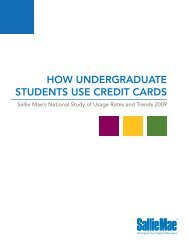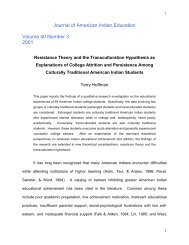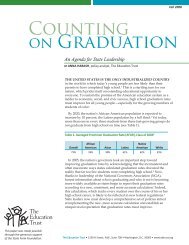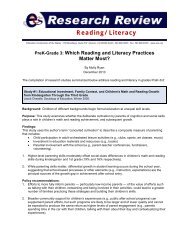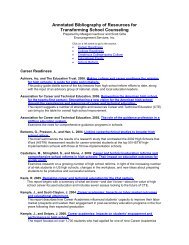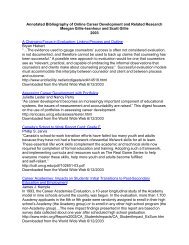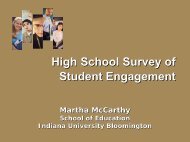Removing Roadblocks to Rigor: Linking Academic and Social ...
Removing Roadblocks to Rigor: Linking Academic and Social ...
Removing Roadblocks to Rigor: Linking Academic and Social ...
Create successful ePaper yourself
Turn your PDF publications into a flip-book with our unique Google optimized e-Paper software.
Promising Policies <strong>and</strong> Practices<br />
To illustrate the various aspects of academic<br />
<strong>and</strong> social support included in this organizing<br />
definition, this section provides examples<br />
of support strategies in schools <strong>and</strong> higher<br />
education institutions. These strategies are not<br />
exhaustive but present a sampling of academic<br />
<strong>and</strong> social support policies <strong>and</strong> practices<br />
being implemented <strong>to</strong> varying degrees along<br />
the P-16 continuum. They reflect a wide array<br />
of approaches <strong>to</strong> motivate, engage, assist,<br />
<strong>and</strong> prepare students <strong>to</strong> meet high academic<br />
st<strong>and</strong>ards <strong>and</strong> succeed in challenging coursework<br />
on both secondary <strong>and</strong> postsecondary levels.<br />
While strategies are organized under one of<br />
the five different types of support described<br />
above—emotional, informational, instrumental,<br />
appraisal, <strong>and</strong> structural—it is important <strong>to</strong> note<br />
that most of these policies <strong>and</strong> practices fall in<strong>to</strong><br />
more than one category. For example, Extended<br />
Learning Time (ELT) is categorized as structural<br />
support because extended time for enrichment<br />
activities is embedded in schools <strong>and</strong> after-school<br />
programs. But ELT also fosters informational<br />
<strong>and</strong> instrumental support by creating space<br />
for students <strong>to</strong> benefit from a range of other<br />
strategies such as tu<strong>to</strong>ring, men<strong>to</strong>rship, <strong>and</strong><br />
positive peer relationships. Similarly, ELT can be<br />
classified—as can other strategies—as either a<br />
policy or a practice, depending on the context in<br />
which it is administered. In Massachusetts, ELT<br />
became a state policy in 2006 after the state<br />
legislature appropriated funding for districts <strong>to</strong><br />
add 30 percent more school time. However, when<br />
schools take advantage of state grants <strong>to</strong> offer<br />
additional learning time, ELT may be characterized<br />
as a practice.<br />
Emotional Support<br />
In order <strong>to</strong> thrive in school <strong>and</strong> college, students<br />
need <strong>to</strong> be surrounded by a network of adults <strong>and</strong><br />
peers who care about their academic success.<br />
Strategies <strong>to</strong> promote emotional support<br />
typically focus on building these relationships<br />
by developing strong interpersonal connections<br />
between students <strong>and</strong> school or college staff <strong>to</strong><br />
reinforce high academic expectations <strong>and</strong> assist<br />
students in meeting them. Policies <strong>and</strong> practices<br />
that enable emotionally supportive relationships<br />
can have a positive impact on academic<br />
achievement by helping students develop the<br />
capacity for strategic thinking, problem-solving,<br />
information-seeking, experimentation, <strong>and</strong><br />
optimism—all of which are associated with<br />
positive academic behaviors. Such relationships<br />
also mitigate the effects of negative emotions<br />
such as anger, blame, denial, anxiety, <strong>and</strong><br />
hopelessness. Emotional support strategies are<br />
operational all along the education pipeline <strong>and</strong><br />
include advisories, men<strong>to</strong>ring, <strong>and</strong> individual or<br />
group counseling (Table I).<br />
Table I: Examples of Emotional Support<br />
Practice Policy<br />
Individual counseling ¸<br />
Group <strong>and</strong> peer support ¸<br />
Men<strong>to</strong>ring<br />
¸<br />
<strong>Social</strong>-emotional st<strong>and</strong>ards<br />
¸<br />
Proactive advising<br />
¸<br />
Activities that develop<br />
strong, supportive<br />
interpersonal connections<br />
amoung students, parents,<br />
faculty, <strong>and</strong> school staff<br />
¸ ¸<br />
PATHWAYS TO COLLEGE NETWORK, INSTITUTE FOR HIGHER EDUCATION POLICY 11







